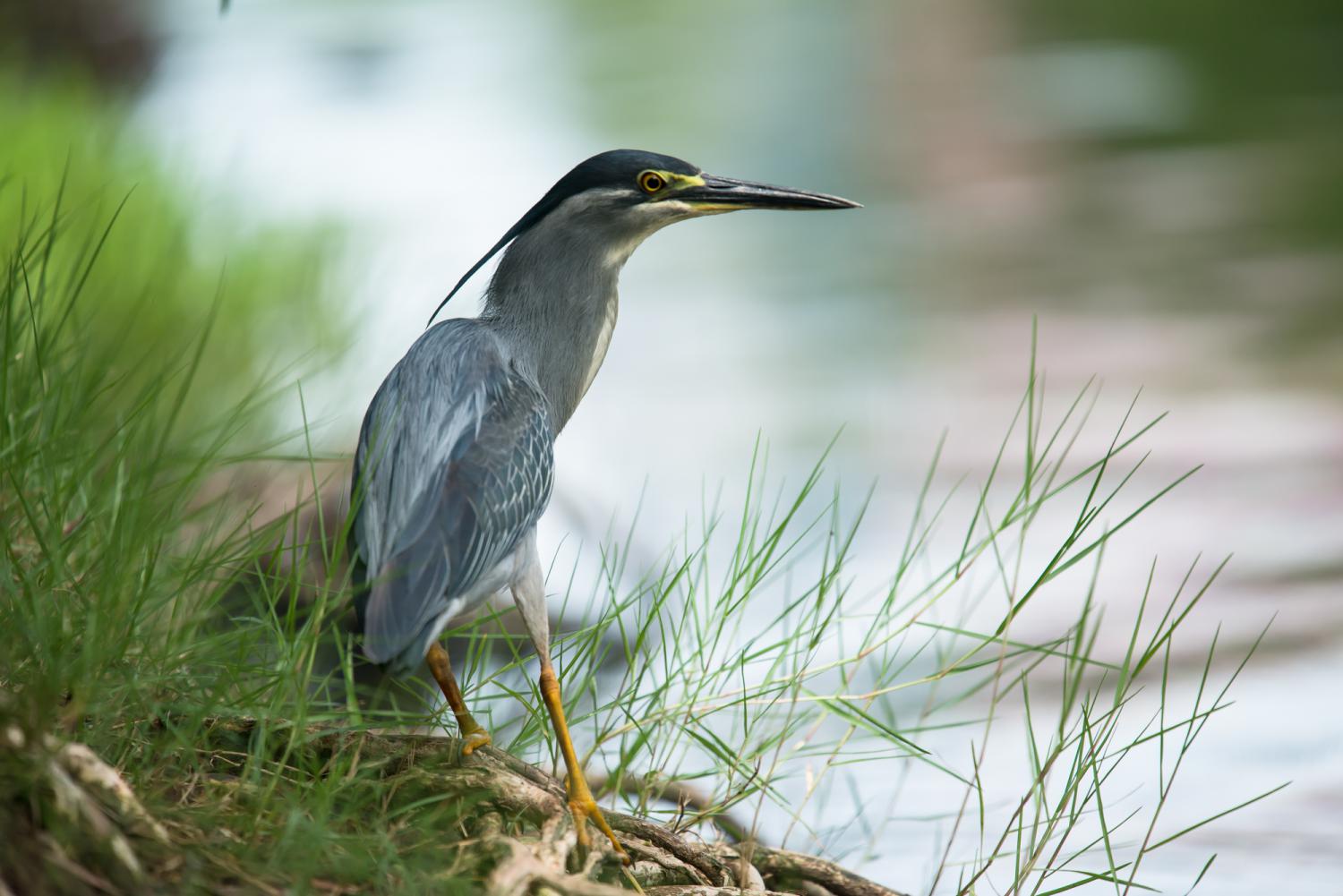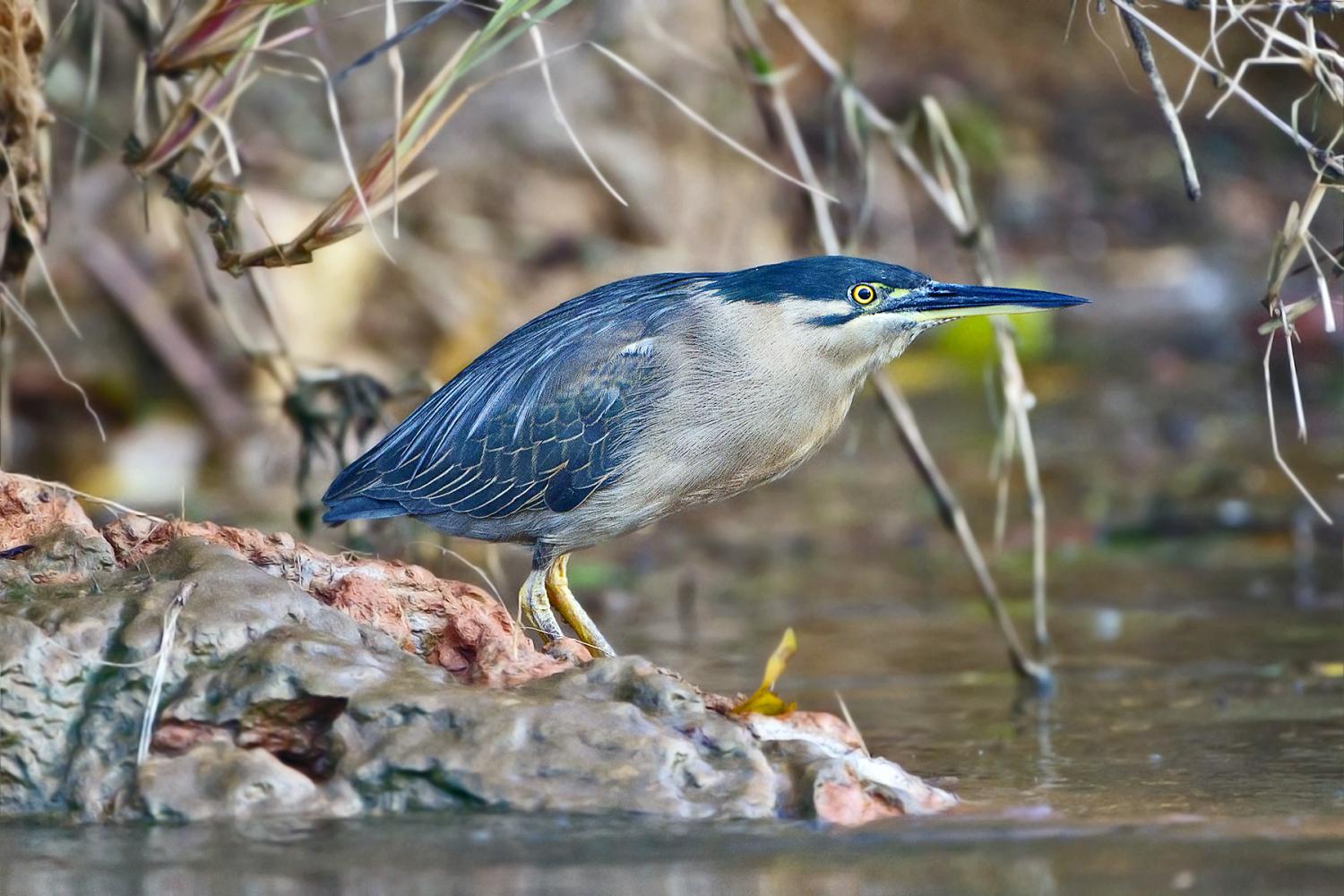Species of Thailand
Striated heron
Butorides striata
Carolus Linnaeus, 1758
In Thai: นกยางเขียว
The striated heron (Butorides striata) also known as mangrove heron, little heron or green-backed heron, is a small heron. Striated herons are mostly non-migratory and noted for some interesting behavioral traits. Their breeding habitat is small wetlands in the Old World tropics from west Africa to Japan and Australia, and in South America. Vagrants have been recorded on oceanic islands, such as Chuuk and Yap in the Federated States of Micronesia, the Marianas and Palau; the bird recorded on Yap on February 25, 1991, was from a continental Asian rather than from a Melanesian population, while the origin of the bird seen on Palau on May 3, 2005 was not clear.
This bird was long considered to be conspecific with the closely related North American species, the green heron, which is now usually separated as B. virescens, as well as the lava heron of the Galápagos Islands (now B. sundevalli, but often included in B. striata, e.g. by BirdLife International); collectively they were called "green-backed herons".
Description and ecology
Adults have a blue-grey back and wings, white underparts, a black cap, a dark line extends from the bill to under the eye and short yellow legs. Juveniles are browner above and streaked below.
These birds stand still at the water's edge and wait to ambush prey, but are easier to see than many small heron species. They mainly eat small fish, frogs and aquatic insects. They sometimes use bait, dropping a feather or leaf carefully on the water surface and picking fish that come to investigate.
They nest in a platform of sticks measuring between 20–40 cm long and 0.5–5 mm thick. The entire nest measures some 40–50 cm wide and 8–10 cm high outside, with an inner depression 20 cm wide and 4–5 cm deep. It is usually built in not too high off the ground in shrubs or trees but sometimes in sheltered locations on the ground, and often near water. The clutch is 2–5 eggs, which are pale blue and measure around 36 by 28 mm.
An adult bird was once observed in a peculiar and mysterious behavior: while on the nest, it would grab a stick in its bill and make a rapid back-and-forth motion with the head, like a sewing machine's needle. The significance of this behavior is completely unknown: While such movements occur in many other nesting birds where they seem to compact the nest, move the eggs, or dislodge parasites, neither seems to have been the case in this particular striated heron.
Young birds will give a display when they feel threatened, by stretching out their necks and pointing the bill skywards. How far this would deter predators is not known.
Widespread and generally common, the striated heron is classified as a species of least concern by the IUCN; this holds true whether the lava heron is included in B. striata or not.
This article uses material from Wikipedia released under the Creative Commons Attribution-Share-Alike Licence 3.0. Eventual photos shown in this page may or may not be from Wikipedia, please see the license details for photos in photo by-lines.
Category / Seasonal Status
BCST Category: Recorded in an apparently wild state within the last 50 years
BCST Seasonal statuses:
- Resident or presumed resident
- Non-breeding visitor
Scientific classification
- Kingdom
- Animalia
- Phylum
- Chordata
- Class
- Aves
- Order
- Pelecaniformes
- Family
- Ardeidae
- Genus
- Butorides
- Species
- Butorides striata
Common names
- Thai: นกยางเขียว
Conservation status

Least Concern (IUCN3.1)
Photos
Please help us review the bird photos if wrong ones are used. We can be reached via our contact us page.
Range Map

- Amphawa District, Samut Songkhram
- Ao Phang-Nga National Park
- Ban Laem District, Phetchaburi
- Ban Sang District, Prachinburi
- Bang Pakong District, Chachoengsao
- Bang Phra Non-Hunting Area
- Bang Pu Recreation Centre
- Bang Saphan Noi District, Prachuap Khiri Khan
- Bangkok Province
- Bueng Boraped Non-Hunting Area
- Chaiya District, Surat Thani
- Chiang Dao Wildlife Sanctuary
- Chiang Saen District, Chiang Rai
- Doi Inthanon National Park
- Doi Lang
- Doi Lo District, Chiang Mai
- Doi Pha Hom Pok National Park
- Doi Phu Kha National Park
- Doi Saket District, Chiang Mai
- Doi Suthep - Pui National Park
- Don Chedi District, Suphan Buri
- Erawan National Park
- Fang District, Chiang Mai
- Hala-Bala Wildlife Sanctuary
- Huai Chorakhe Mak Reservoir Non-Hunting Area
- Huai Talat Reservoir Non-Hunting Area
- Kaeng Krachan National Park
- Kamphaeng Saen District, Nakhon Pathom
- Khao Ang Rue Nai Wildlife Sanctuary
- Khao Lak - Lam Ru National Park
- Khao Luang National Park
- Khao Nam Khang National Park
- Khao Phanom Bencha National Park
- Khao Phra - Bang Khram Wildlife Sanctuary
- Khao Phra Thaeo Wildlife Sanctuary
- Khao Sam Roi Yot National Park
- Khao Sok National Park
- Khao Yai National Park
- Khao Yoi District, Phetchaburi
- Khlong Lan National Park
- Khlong Luang District, Pathum Thani
- Khlong Saeng Wildlife Sanctuary
- Khon San District, Chaiyaphum
- Khuan Khanun District, Phatthalung
- Khung Kraben Non-Hunting Area
- Khura Buri District, Phang Nga
- Klaeng District, Rayong
- Ko Chang National Park
- Ko Lanta National Park
- Ko Libong
- Ko Phayam
- Ko Phra Thong
- Ko Samui District, Surat Thani
- Ko Sichang District, Chonburi
- Kumphawapi District, Udon Thani
- Laem Ngop District, Trat
- Laem Pak Bia
- Lam Nam Kok National Park
- Lan Sang National Park
- Mae Ai District, Chiang Mai
- Mae Charim National Park
- Mae Rim District, Chiang Mai
- Mae Sai District, Chiang Rai
- Mae Wong National Park
- Mu Ko Chumphon National Park
- Muak Lek District, Saraburi
- Mueang Buriram District, Buriram
- Mueang Chiang Mai District, Chiang Mai
- Mueang Chonburi District, Chonburi
- Mueang Kanchanaburi District, Kanchanaburi
- Mueang Khon Kaen District, Khon Kaen
- Mueang Krabi District, Krabi
- Mueang Lampang District, Lampang
- Mueang Nakhon Nayok District, Nakhon Nayok
- Mueang Nakhon Pathom District, Nakhon Pathom
- Mueang Nonthaburi District, Nonthaburi
- Mueang Pattani District, Pattani
- Mueang Phang Nga District, Phang Nga
- Mueang Phetchabun District, Phetchabun
- Mueang Phetchaburi District, Phetchaburi
- Mueang Phuket District, Phuket
- Mueang Ranong District, Ranong
- Mueang Ratchaburi District, Ratchaburi
- Mueang Samut Sakhon District, Samut Sakhon
- Mueang Samut Songkhram District, Samut Songkhram
- Mueang Satun District, Satun
- Mueang Sisaket District, Sisaket
- Mueang Sukhothai District, Sukhothai
- Mueang Suphanburi District, Suphan Buri
- Mueang Surin District, Surin
- Mueang Tak District, Tak
- Nam Nao National Park
- Nam Phong National Park
- Namtok Sam Lan National Park
- Non Din Daeng District, Buriram
- Nong Bong Khai Non-Hunting Area
- Op Khan National Park
- Pa Sang District, Lamphun
- Pak Chong District, Nakhon Ratchasima
- Pak Kret District, Nonthaburi
- Pak Phanang District, Nakhon Si Thammarat
- Pak Phli District, Nakhon Nayok
- Pak Thale
- Pathio District, Chumphon
- Pha Taem National Park
- Phanat Nikhom District, Chonburi
- Phi Phi Islands
- Phra Nakhon Si Ayutthaya District, Phra Nakhon Si Ayutthaya
- Phu Chong Na Yoi National Park
- Phu Khiao Wildlife Sanctuary
- Phu Luang Wildlife Sanctuary
- Phu Suan Sai National Park
- Phutthamonthon District, Nakhon Pathom
- Pran Buri District, Prachuap Khiri Khan
- Pran Buri Forest Park
- Sai Noi District, Nonthaburi
- Sai Yok National Park
- Salawin National Park
- Samae San Island
- Samut Prakan Province
- San Sai District, Chiang Mai
- Sanam Chai Khet District, Chachoengsao
- Sathing Phra District, Songkhla
- Sawi District, Chumphon
- Si Racha District, Chonburi
- Sikao District, Trang
- Similan Islands
- Sirinat National Park
- Sri Phang-nga National Park
- Surin Islands
- Tai Rom Yen National Park
- Takua Pa District, Phang Nga
- Taphan Hin District, Phichit
- Tha Takiap District, Chachoengsao
- Tha Yang District, Phetchaburi
- Thalang District, Phuket
- Thale Ban National Park
- Thale Noi Non-Hunting Area
- Than Sadet - Koh Pha-Ngan National Park
- Thanyaburi District, Pathum Thani
- Thong Pha Phum National Park
- Ton Nga-Chang Wildlife Sanctuary
- Wang Chan District, Rayong
- Wat Phai Lom & Wat Ampu Wararam Non-Hunting Area





